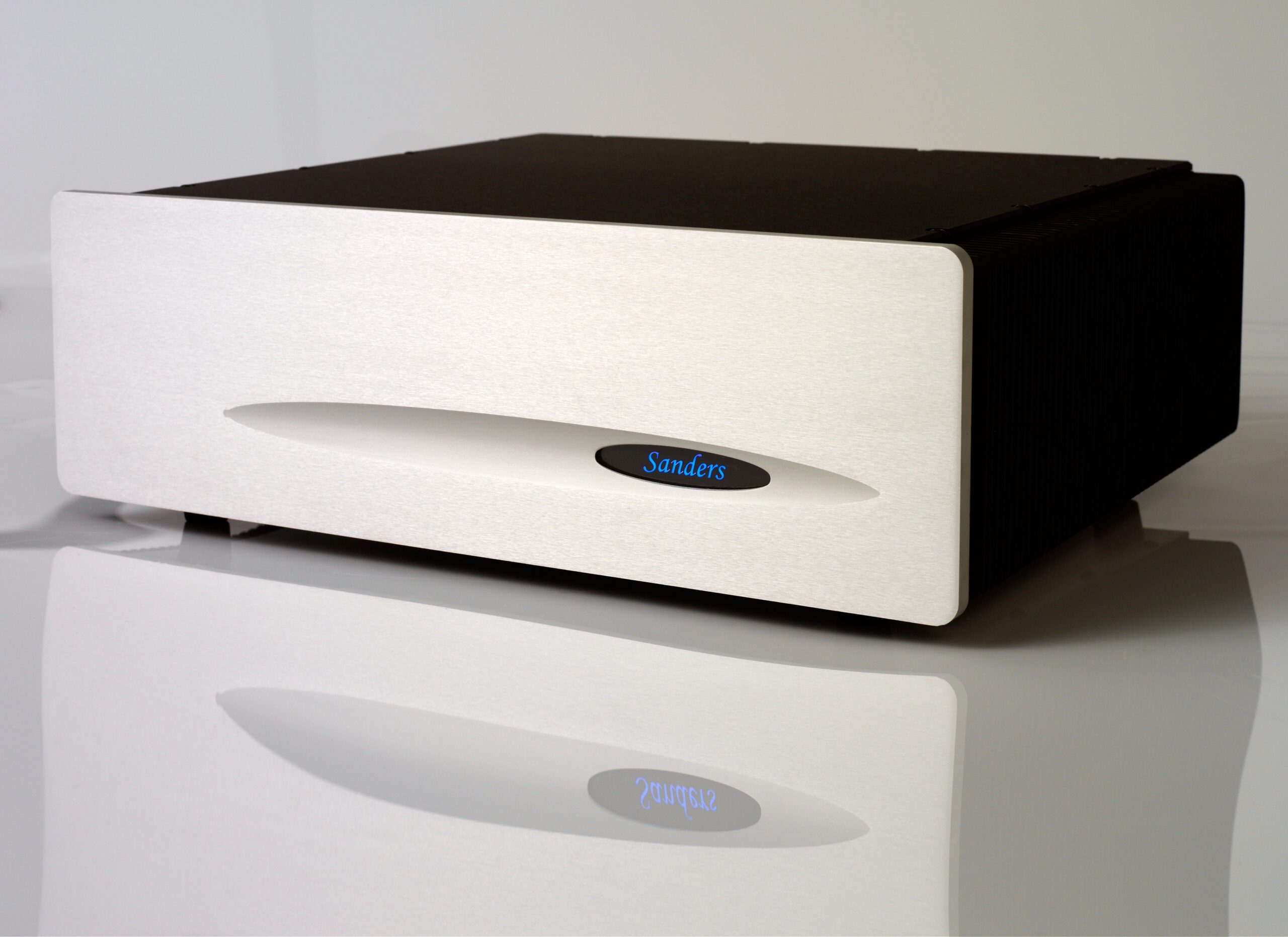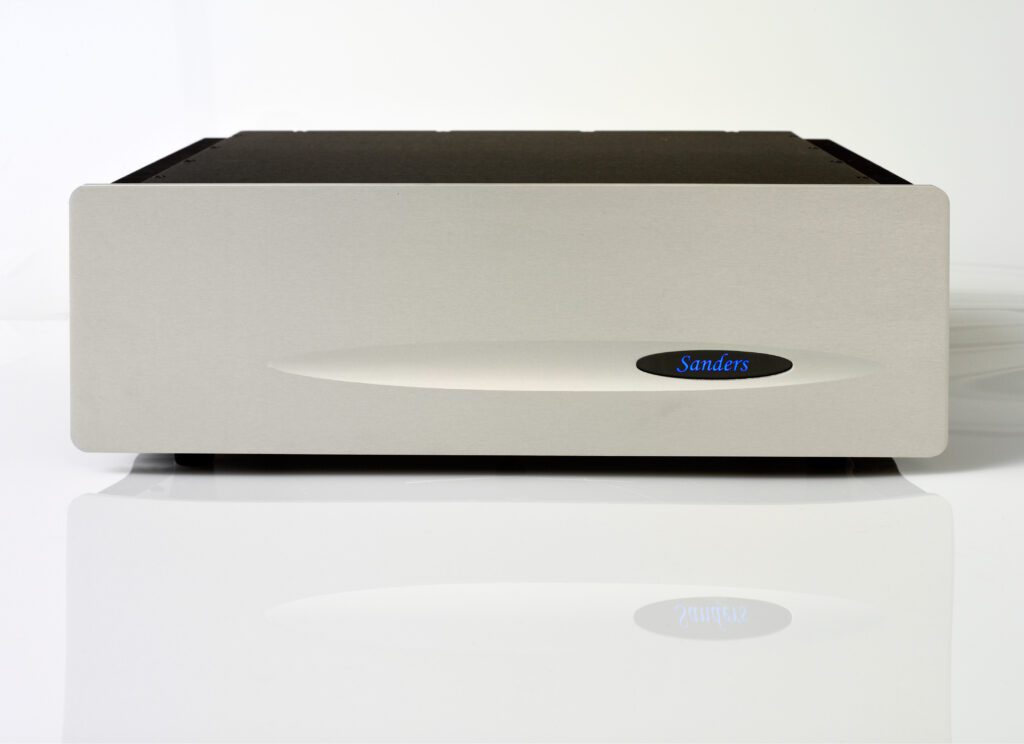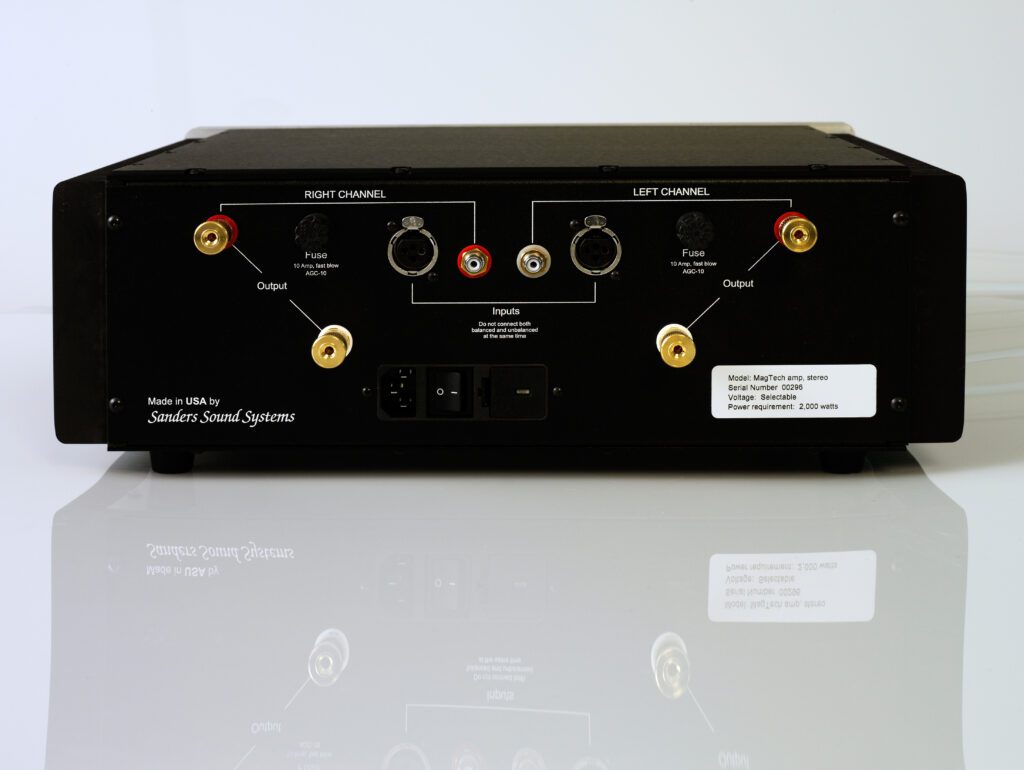
The Sanders Sound Systems Magtech is not your ordinary Class AB amplifier.
Sanders Sound Systems has been around for over four decades. Based in Conifer Colorado, USA, Founder Roger Sanders is a scientist and engineer first and foremost. His interest in Electrostatic loudspeakers has led to the creation and continued development of the Model 10 Electrostatic Speaker. The Model 10 has been rightly feted with many awards for its lifelike presentation and accuracy. Generally, Electrostatic speakers have required a lot of power and stability from an amplifier to maximize their qualities. Roger, not being satisfied with what the market offered, spent two years developing the Magtech amplifier to drive the Model 10’s.
At first glance, the Magtech amplifier (I received the stereo version. The mono amps look identical.) is handsome, but unassuming. Enclosed in an understated black aluminum case with a classy not flashy thick front panel with the Sanders logo in a subtle blue light and heat venting fins that will not slice your hand to pieces, the Magtech sits on your shelf looking very business-like. Weighing in at a manageable 25 Kg the amp is easily moved as needed. On the back you find XLR and RCA inputs alongside speaker terminals that will accept spades, bananas, or bare wire. So far, no surprises. It is when the insides are considered that you begin to discover the Magtech is not your ordinary Class AB amplifier.

Speaking with Roger Sanders about his design goals for the Magtech, he indicated that to have an amp that has a lot of control over the speakers, he needed a lot of power. Indeed, the Magtech stereo amp provides 500 wpc into 8 Ohms and 900 wpc into 4 Ohms alongside an extremely low output impedance. Most important though is the fully regulated power supply. The “why this matters” question gets to the heart of Sanders design philosophy. He is a scientist and engineer rather than an audiophile. He is an objectivist to the core and will make sure his designs spec to the best level he can manage. The result will be performance not only beyond what is likely necessary for any pair of speakers but at a constant throughout the power demand that any speaker or music dynamic would require to maintain maximum unaltered signal quality.
To get to the heart of it, Sanders has found that free-floating power supplies cannot maintain their proper voltage during peak music events. The drop in voltage reduces the available output power significantly and it leads to clipping reducing the quality of the amplified signal. Thus, the critical need for a fully regulated power supply. He has invented the first fully regulated power supply that generates virtually no waste heat. It is almost 100% efficient. This power supply maintains its voltage, high power, and bias level regardless of the load placed upon it. Sanders indicated he uses the latest thermal track transistors by Motorola which keeps the bias under tight control. So, he can run the amp at low bias while maintaining very low distortion levels at around 0.0001%. He also stressed that this amplifier had no protective circuitry as that leads to compromises when powering electrostatic speakers. So how do you keep from blowing up your output transistors? The answer is he uses a whole lot of powerful output transistors to reduce the strain on any single one. Looking at the picture of the amps internal circuits will show twenty transistors per channel wired in parallel spreading the stress across the group of them and lowering the impedance to around 1/100th of an Ohm which means it can deliver all the current a speaker needs regardless of frequency or impedance.
Sanders stated that the audio press spends little time discussion protective circuitry. Everyone is looking for the holy grail of an amplifier that sounds good all the time. They usually think that one sounds better than another because of design parameters but in his view in most cases that is not true. A solid-state amp that has a transistor sound is not due to having transistors but due to the fact is has protective circuitry. When protective circuitry is triggered, it cuts the power to the output circuitry. It does this rapidly so it does not have an obvious chopping off the music but that is exactly what is happening several hundred times a second. When that happens, you have gaps in the music however brief or small. They are still discernible. On an oscilloscope you can see the music being cut on and off as the protective circuitry is being applied. Voltage spikes from a light switch or an output transistor also impact the linearity of the music signal. So protective circuitry leads to gaps in the music with voltage spikes on either side of that gap. It is no wonder this sounds bad. There is significant distortion and a limitation of the power available from the amplifier. This is usually perceived as brittle, harsh or edgy when describing the sound. Perhaps the biggest negative is the protective circuitry is triggering on peaks which are very short, so the listener is not recognising the distortion during that brief peak. The average level still sounds clean because you are not triggering the protective circuitry, yet the amp is still described as brittle and edgy.
Anyone wishing to take a deeper dive into Sanders’ design philosophy should check out the highly detailed technical white paper found on the Sanders Sound Systems website (http://www.sanderssound.com/technical-white-papers/161-the-magtech-regulated-power-supply-wp).
Installing the Magtech into my reference system meant disconnecting a pair of highly regarded Class AB monoblock amplifiers. I have enjoyed these amps for many years, and they have always provided excellent grip on my 87dB efficient Vandersteen Quatro Wood CT’s. The Magtech certainly took up a lot less floor space as the mono’s each weighed nearly twice what the Magtech does. I was more than happy to reduce the mass I had to move around the room. Given the disparity in size I was very intrigued to see how the Magtech would perform. As it turned out I should not have worried about the Magtech. It held up just fine.
Queueing up the title track to the new James Bond movie, No Time to Die by Billie Eilish [Interscope 2020] via my Cary DMS-700 DAC/Streamer and my Luxman CL-38uC Preamp I was hoping for a nice surprise. This would be a great song even if it was not a movie title. The sweeping orchestral sound and soft vocals provides a good test for an amplifier’s dynamics and range. The Magtech/Vandersteen pairing was terrific as the sub sonics even at low levels provided a solid backdrop to the delicate beginnings of the song. As the energy builds the power and space became filled with precise soundstage positioning. Billie’s almost ghostly vocals took on a near three-dimensional quality floating in the centre of the presentation. The experience was exceptional and gave an early indication of why a regulated power supply can be a secret weapon in high quality audio. Staying with the Bond theme I moved on to Skyfall [Columbia 2012] sung by Adele. Again, the consistency of the presentation quality across a wide dynamic range was thrilling. I cranked the volume louder than I had ever done on the Vandersteen’s and the sonics were consistently clear and musical. When the brass came in during the chorus the power of the French horns and Baritones was gripping as Adele’s pure voiced soared over the orchestra. A truly auspicious start.
Moving on to some Donald Fagen, ‘Slinky Thing’ from Sunken Condos [Reprise 2012] has a funky bass line and a strong yet understated pacing that keeps the song moving. Bells and chimes rang around the space creating a sense of dimension. What kept creeping into my consciousness was the sense of foundation and solidity. Regardless of the volume I used or the pianissimo to fortissimo being offered you could feel the support flowing through the music. It was something I greatly appreciated and never realised I was missing. It was truly an epiphany. I had never noticed this regardless of the type or price of amplifier I had listened to previously. Quite a feat for a mid-priced solid-state amplifier.
I occasionally enjoy some opera. Pavarotti’s Donizetti: Una Furtiva Lagrima [Deutche Grammophon 2009] shows the Maestro in great form with his beautiful voice taking command of this stunning aria. The Magtech provided a strong stage for his performance. As his voice transitioned from soft to strong it was always delivered from a place of solidity. Focus and nuance were delivered as I would expect from a live performance. It was moving as I would expect and should insist on.
What had become obvious is this amplifier was exceptional in its ability to present and support any music presented to it. Power was clean and always available regardless of the sonic demands being placed on it. Yet the Magtech also delivered nuance and musicality. It was an amp that would clearly satisfy the audiophile, yet it would also satisfy the engineer in its specifications and output measurements. One of the accepted realities from my more subjectivist view (if it sounds good to me, I generally am not concerned by the numbers) was that tubes and class A can be a sonic holy grail. I still am a big fan of a great low power SET amplifier yet none of them I have experienced provided underlying substance to the music the way the Magtech did. Not to say I would stop listening to them as they are a different flavour of presentation. Yet I will know something is missing.
So, what struck me the most when listening to music with the Magtech? It was the groove. I was playing Led Zeppelin’s signature hit ‘Stairway to Heaven’ [Led Zep IV, Atlantic, 1971] John Bonham and John Paul Jones were backstopping the slow build from quiet folk styled beginning to driving rock and roll end with precise authority. Somewhere during the music, I began to understand Roger Sanders point about why a regulated power supply was so critical to the delivery of the music. As the sound continued its crescendo with Jimmy Page and Robert Plant coming into the fore the naturalness and authority of the presentation never wavered. Nothing remotely brittle or edgy. It was this more life-like sonic consistency that makes the Magtech amplifier stand out from the crowd. The stated watts per channel are real with plenty of headroom for peaks and dynamics.

I had to remember that this was an amplifier designed to run electrostatic speakers effortlessly, so well does this amplifier drive dynamic loudspeakers; even loudspeakers with seemingly ‘punishing’ impedance loads. In fact, the load of a conventional speaker presents a much easier challenge to the Magtech. If you get the chance to demo the Sanders Sound Systems Magtech power amplifier you should take advantage of that opportunity. Like other products in the Sanders line, the Magtech amplifier is a remarkable piece of kit that deserves more attention from the press than it gets and comes very highly recommended.
SANDERS SOUND SYSTEM MAGTECH POWER AMPLIFIER TECHNICAL SPECIFICATIONS
- Power (Stereo Version): 500 watts RMS per channel into an 8-ohm load; 900 watts RMS per channel into a 4-ohm load
- Bandwidth: DC through 100kHz
- Class of Operation: Class AB
- Input Impedance: 100K unbalanced, 1K balanced
- Input voltage required for full output: 2.2 Volts
- Noise: More than 110dB below rated output
- Gain: 26dB
- THD: Less than 0.01%
- Damping Factor: Greater than 600 into an 8-ohm load
- Voltage: Voltage is user selectable for use world-wide
- Weight: 25 Kgs
- Dimensions (WxHxD): 43cm × 15.2cm × 40.6cm
(including feet and binding posts) - Price: $7,000
Manufacturer:
Sanders Sound Systems
12054 Deer Trail Road
Conifer, CO 80433
USA
Tel: +1 303-838-8130
URL: sanderssound.com
By Eric Neff
More articles from this authorRead Next From Review
See all
PrimaLuna EVO 100 phono preamplifier
- Apr 22, 2024

Reiki Audio SuperSwitch Master Pro + Servant Pro
- Mar 27, 2024

Melco Audio N1-S38 music server
- Mar 27, 2024











